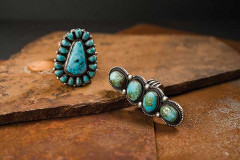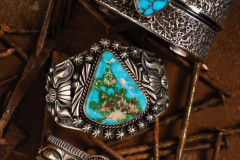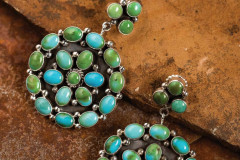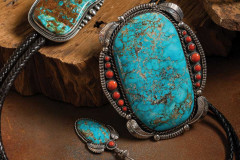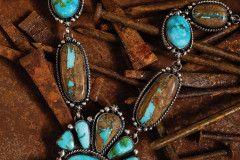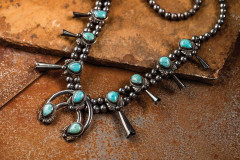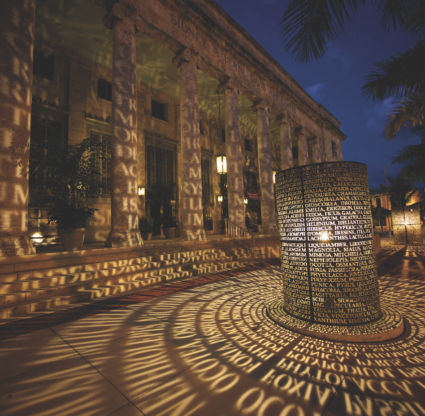Mined from desert landscapes, turquoise is regarded as one of the most powerful talismanic stones. Within Native American tribes—from whom Tim Brick of Naples’ Four Winds Gallery sources most of his turquoise—the stone remains a strong intergenerational link, economic driver and cultural emblem.
After selling his rock club in Pittsburgh, Tim and his now-wife, Susan, moved to Naples to start their second act. The couple had begun collecting turquoise and were fascinated by the stone’s lore and beauty. Today, their 41-year-old gallery, off Third Street South, is one of the best turquoise jewelry boutiques in the country.
While fine jewelry brands are using more and more turquoise in their designs, we’re partial to Native American jewels that carry generations of meaning and craftsmanship—from the Navajo people’s intricate, heavy silversmithing to the Zuni people’s delicate cluster work. Indigenous stories say the azure stone promotes protection, happiness, luck and health. On a style note, turquoise complements all skin tones, giving you an instant glow.
Arizona-mined Bisbee is one of the rarest and most valuable forms of turquoise. Silversmith Jennifer Curtis places the stone front and center in her repousse cuff (pictured below). “Her father, Thomas, was very well known when he was alive,” Tim says. “She learned from him and surpassed his skills—this is one of the most prized pieces I bought this past summer.”
To many, the matrix (spidery veins in contrasting stone) makes turquoise more special. Nevadan Royston mines’ turquoise is known for its vibrant blues and greens swirling with an umber matrix. “This is the nicest necklace I’ve ever seen with that combo,” Tim says. “Most of the time, you only have a fleck of turquoise.” (pictured below)
Featured Styles (in the order they appear above). Click on an image to enlarge:
- Clarissa and Vernon Hale Kingman turquoise ring; Calvin Martinez’s Sonoran gold turquoise ring.
- Aaron Anderson Egyptian turquoise tufa-cast cuff (made using a mold hand-carved from the volcanic tufa stone); Aaron Toadlena 1930s-inspired, Sonoran gold turquoise cuff.
- Clarissa and Vernon Hale cluster-style earrings
- The bolo tie emerged in the 1930s as a laidback alternative to neckties in the West. The circa-1970s Castle Dome turquoise tie (front) makes a statement, measuring about 5 inches long and 4 inches wide. Ernest Begay Easter-blue turquoise bolo (back).
- Royston ribbon and Sonoran gold turquoise necklace by Navajo artist Angela Martin.
- Circa-1960 ‘child’ squash blossom necklace (one of the most traditional Native American jewelry styles)
Photography by Anna Nguyen


